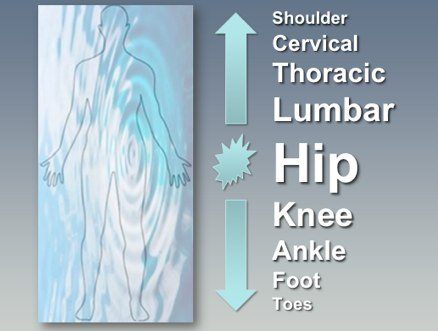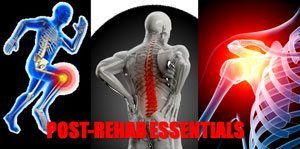Today’s guest post comes from Dean Somerset discussing 4 things he thinks we are doing wrong with rehab. Great job Dean, I always love reading your stuff! If you want to hear more from Dean (and you definitely should!) I recommend you check out Dean’s new Post-Rehab Essentials program. It is over 12 hours of great content. I am still reviewing but have enjoyed it so far, I’ll try to post a full review once I get a chance to finish it all!
4 Things We Are Doing Wrong With Rehab
I’ve built up a profession working the grey zone between where physiotherapists and traditional rehabilitation professionals leave off with their patients and where strength coaches and persona trainers begin. There’s a definite gap between the two, and hopefully more and more trainers and rehab professionals will be able to bridge this gap to effectively help their clients and patients, respectively, through the entire continuum of wellness. Today’s post will hopefully show a few ways to bridge the gap in a more practical sense for some of the common things that aren’t being adequately addressed by either side.
#1. Not looking at foot mechanics – For Everything
A simple test I use with a lot my classes: I get everyone to put their arms overhead as straight and high as possible with a tall and upright posture. Then I have them make their upper back kyphotic, and try to do the same thing, and watch everyone’s expression as they wind up getting half the range of motion necessary. Then I have them do both a posterior and anterior pelvic tilt and see what happens. Yep, you guessed it, less range of motion. As the grande finale, I have them stand tall, and then simply pronate their feet to see what effect it has on their shoulder range of motion. Most if not all involved, will have some reduction in their ability to abduct their arms. Give it a try and see what happens.
Mike made an excellent post a few months back about the kinetic chain ripple effect versus the kinetic chain, and this is an excellent example of that concept. When the spine was kyphotic, it had the most dramatic effect on shoulder mechanics than when the foot was pronated, but the effect was still there, much like ripples in the lake from a stone hitting the surface on the other shore. This shows that even if the foot isn’t directly involved in a lot of issues with the body that it may in fact be indirectly involved with issues of the knee, hip, spine, and even shoulder and neck.
By checking to see if the foot has a fallen, normal or high arch structure to it, as well as if any arch alterations are structural in nature (the bones are formed that way) versus postural in nature (the muscles holding the ankle are weak) can allow a practitioner to get one more piece to the puzzle. If the arch has fallen due to weak muscle support through both the tibialis posterior and the compound effect of a weak greater hallicus longus, you can train the muscles of the foot to stabilize and resist collapsing, which would prevent the internal rotation of the tibia, and everything that would result up the chain.
Altered foot mechanics can affect every movement, from heavy deadlifting (my drug of choice) to how you throw a fast ball, to how at risk you are of low back pain.
#2. Not watching runners’ stride and technique
I’m fortunate enough to have been able to work with a lot of distance runners, even though I consider distance running one of the most pointless activities you could ever do. Seriously, if you have that far to go, drive there. You get a cup holder and air conditioning. Be that as it may, I’ve been able to do hundreds of run stride analyses clients, from beginners looking to complete their first 5km race, to elite marathon and ultra marathon runners looking to shave time, and even those who had repetitive strain issues with their legs and needed to know why. You can see amazing things happen when you use even a basic digital video camera and slow down the replay to watch things like calcaneal eversion, midfoot pronation, valgus collapse, tibial rotation (both internal and external), pelvic stability on impact, foot strike mechanics, knee position and angle on impact, stride length and frequency, and even whether they are in the right shoe for their stride or not. We could debate barefoot versus shod running forever, but I’ll just leave it to say that barefoot isn’t for everyone, and typical running shoes aren’t for everyone either.
A lot of repetitive strain injuries in runners could be corrected by simply altering their run mechanics, much like a golfer can reduce their incidence of golfers elbow and low back pain by receiving coaching on proper swing mechanics. This could be as simple as using a hand-held video camera to show real-time feedback about performance, or as complex as using a DartFish software package to analyze force vectors and angle and rate of pronation, but in each situation it would result in an improvement in run stride, which would reduce the stress on the involved tissues, and allow runners to keep running with less pain, and probably while going faster.
It’s one thing to watch someone in static posture, and another entirely different beast to watch them move in their desired activity. By simply working on the muscles, joints, and fascia, we’re missing the boat on how their activities are impacting those tissues and what can be done about it. Athletes in most sports that involve running in one way or another (basketball, soccer, field hockey, and to a lesser degree football and baseball) would benefit from having someone analyze their gait and see where there may be some energy leaks and ways to decrease risk of injury.
#3. Not checking breathing mechanics
With the majority of upper body muscles attaching in one way or another to the rib cage, it would be common sense to think that an alteration in breathing mechanics could alter not only core function, but also scapular, glenohumeral, cervical, and potentially even lumbopelvic and lower leg function. If a client isn’t breathing properly through one side of their lungs, they may wind up getting side stitches on the opposite side as it works extra hard to compensate during forced heavy breathing. If they aren’t using their diaphragm properly, they may get neck cramping as their scalene compensate for the short-comings, and so on. On top of that, if the ribs cannot expand and contract properly, it will affect the ability of the thoracic spine to extend and rotate, which will affect the mechanics of the above-mentioned body parts. If they are collapsing into kyphosis, it will alter breathing capacity, which will alter performance and lead to further postural and repetitive strain issues.
Here’s an example of a runner who came in to see me with shoulder pain during her runs.
Notice how the rib cage elevates, but doesn’t actually expand width-wise? Here’s what she looked like after two weeks of doing three breathing exercises each day.
She’s still restricted, but using her lower ribs more instead of just relying on scalenes and upper ribs to do her breathing. This is a woman who can run at 10 miles an hour for ever and hold a conversation with you, and has won marathons, Death Races, ultra marathons, and 50-100 mile trail running races galore, all while only using about one third of her lungs. She shaved 6 minutes off her personal best marathon time by only altering her breathing mechanics and stretching her thoracic spine through extension and rotation.
#4. Not communicating with everyone involved
I’ve been able to work with a lot of good rehab professionals who have been willing to discuss their patients’ status and ways to help them out in our training sessions, and also take my observations and questions in stride. I’ve also worked with a few who weren’t so willing to work with me, and as a result the quality of care wasn’t as good, and the results that the client was able to get were less than optimal.
One of the first questions I ask any rehab professional when it comes to any workouts I’m going to have them do is quite simply “What do you want me to focus on, and what should I avoid?” Essentially, I’m always going to defer to the direction of the doctor or physiotherapist or chiropractors’ directives, and work my program around their guidelines. I may question certain aspects based on the results of my assessments, and occasionally can give them some new information, but most of the time my questioning is to get more information and to learn more from another set of eyes and educational background.
The same could be said in the reverse direction. If your patient is working with a personal trainer or strength coach, reach out to them and ask to discuss their training program. Odds are you can both come to a collaborative conclusion that will only benefit that patient, and result in them getting healthier faster and make you look good to everyone involved. One example stands out in my mind of a client who came in with really severe brachial plexus impingement in both arms, had been to physiotherapists and chiropractors, and seen no relief. I wanted to talk with her neurologist to see if there was anything that I should work on or avoid, and his response was amazing.
“I don’t know, just get her to lose some weight and increase her flexibility. If she says it hurts, move on to something else.”
I then proceeded to refer her on to a really good physiotherapist in my area who checked her out and gave some very good and specific recommendations, and within 6 weeks her pain was nearly half of what it was. The combined approach will always work best.
Strength coaches and personal trainers who don’t have an established network of health care practitioners scare me, and they should scare anyone who is willing to work with a trainer, especially if they already have specific medical or injury concerns. I’ve had countless situations where I needed a second opinion and referred a client out to get an assessment and report back on what they can and can’t do, and as a result we’ve been able to train longer and avoid aggravating issues further. I’m paranoid about making client safety an issue, because if that client isn’t able to train and I can’t find a way to make them better, it affects my bank account at the end of the month, and my reputation as a whole. Having medical referral networks makes trainers money, and increases their respect and reputation. Not having qualified professionals they can ask for help makes them a liability.
For more great information from Dean, be sure to check out his Post Rehab Essentials Program. It’s a 12-hour program that goes over great topics such as above. It is a great resource for the personal trainers that deal with people coming off of injuries.







